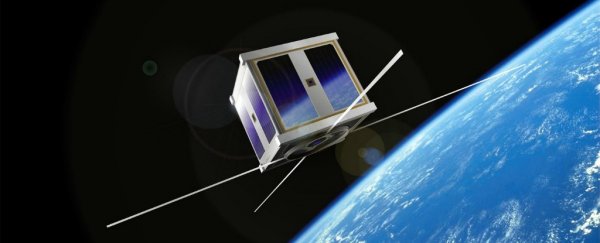An international team of scientists is getting ready to launch 50 mini-satellites called CubeSats into Earth's thermosphere - the outermost layer of our atmosphere that we know relatively little about.
Finding out more about the thermosphere - which is situated between 200 and 380 kilometres above Earth's surface - is crucial, because we rely on it to protect us from the harsh conditions of space.
Instead of sending the 50 mini-satellites up into the thermosphere from Earth, they'll be launched from the International Space Station (ISS), and their job will be to feed back data on how our outer atmosphere functions.
"This region is poorly understood and hard to measure. And yet, it's the interface between our planet and space," said Andrew Dempster, one of the team from the University of New South Wales (UNSW) in Australia. "It's where much of the ultraviolet and X-ray radiation from the Sun collides with Earth, and generates auroras and potential hazards that can affect power grids and communications."
The 50 CubeSats are part of an international project called QB-50, involving researchers from 28 countries, including Europe, Japan, the US, and Australia. CubeSats are tiny satellites, measuring approximately 10 cm each side, and weighing around 1 kilogram each.
It's an exciting move for Australia in particular, which is one of the only OECD countries without a space agency.
The three Australian satellites are named UNSW-Ec0, INSPIRE-2w, and SUSat. UNSW-Ec0 will study the atomic composition of the thermosphere, while INSPIRE-2 - a joint project between the University of Sydney, UNSW, and the Australian National University - will measure the electron temperature and density of plasma in the region. SUSat is being created by the University of Adelaide.
"This is the most extensive exploration of the lower thermosphere ever, collecting measurements in the kind of detail never before tried," said Elias Aboutanios, project leader of UNSW-Ec0. "The satellites will operate for three to nine months – and may last up to a year – orbiting this little-studied region of space, before their orbits decay and they re-enter the atmosphere and burn up."
The researchers are excited about the potential data collected by the 50 satellites, and the best part is that the CubeSats are a lot cheaper to launch than large satellites, which means you get more data for your money.
"If you put one very expensive large satellite up, you'll get one data set and that will be it and it'll cost you an awful lot of money, but if you have 50 satellites, you get 50 data sets and it hasn't cost you as much money," Naomi Mathers, from the Advanced Instrumentation Technology Centre in Canberra, told The Sydney Morning Herald last month.
That being said, these satellites still aren't cheap, costing around US$750,000 each to produce.
The actual launch date is currently scheduled for December, and will be sent to the ISS using the Orbital ATK Antares rocket from Wallops Island, Virginia. They'll then take about a month to be deployed from the ISS, drifting down from ISS's 380 km orbit to the lower regions of the thermosphere.
Check out the video below to see what the UNSW-Ec0 will look like in action:
Bring on January. We're excited to see what all these mini-satellites can find.
UNSW Engineering is a sponsor of ScienceAlert. Find out more about how they're solving the world's problems.
